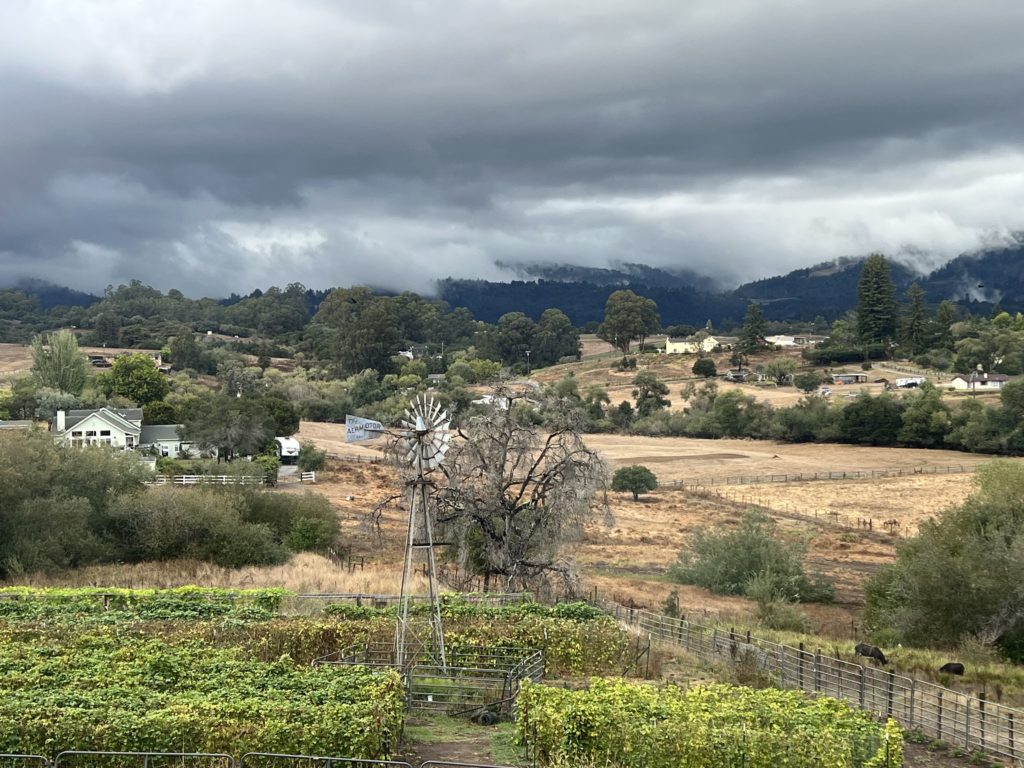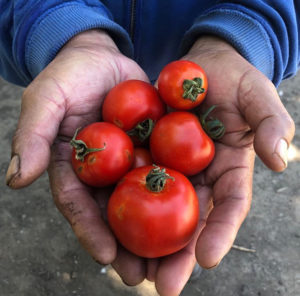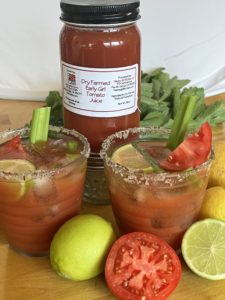Tomato Season

As I sit down to write this note to you I can hear the rain hitting the roof. This is as early in the season as I can ever remember of us getting a meaningful amount of rain, so the question on everybody’s mind is, “How long into the fall do you think we’ll have tomatoes?”
If I could answer that question accurately, reliably, and consistently, I’d be a billionaire-shaman figure, not a puzzled dirt farmer.
I CAN tell you when we will plant the tomatoes; it’s always on April 15th, give or take a few days. By April 15th the danger of frost will have largely passed and the soil will have warmed enough to welcome tomato plants. Often, we will see tiny tomato weeds born from the seeds of last years’ ground fall fruit sprout on their own around this time of year. After we plant the first crop, we will usually follow up with several sequential plantings so that we can enjoy a harvest spread out of the whole season.

Dry Farmed Early Girl Tomatoes
I can tell you when we’re likely to have our first fruit of the season. True, the weather being relatively cooler or hotter can push the date of the first harvest or retard it, but we always see the cherries first in late June, we see the first Early Girls in mid-July, as well as the first Heirlooms. By late August we see the San Marzanos. All of these crops are “indeterminate,” meaning that they can continue to flower and fruit over a long season. Tomatoes are tropical in origin, having first evolved as a food crop in Ecuador around 7,000 years ago. As long as the weather stays “tropical,” the tomatoes stay happy, but they succumb quickly to the elements when conditions become cold, damp, and wet. We have a tomato plant in our greenhouse that is several years old and at least 10 feet high, because the nighttime lows in the greenhouse never drop into the 30s.
We count on having good conditions for tomato production from April thru October. Sometimes a late frost or an early rain will set the crop back or stall it out early. I remember an April 16th frost that zapped our planting pretty badly, but the roots and stems survived and re-sprouted and it turned out to be an ok year. And one year we had a pretty major rainstorm on October 3rd. Later in the season, when the nights are longer and there’s less time for the plants to dry out, a drenching rain can give rise to leaf rot in the middle of the dense canopy of foliage, and the tomatoes will soon sicken and die.
A rain that falls earlier in the year, like the one we are experiencing right now, may not have a lethal consequence. If the days are still long enough or breezy enough for a tomato plant to dry out promptly a rain can be a good thing. Pest mites like the Two Spotted mite that happily chew on tomato plants thrive in dry, dusty conditions. Clean and humid environments favor their enemy, the Persimilis mite, which feeds on the Two Spotted mite. A quick, cleansing rain can encourage the beneficial, predatory mites, even as it discourages their prey.
If this year’s crop is not adversely affected by this passing rainstorm, then I’ll hope that we will be able to harvest thru October, and maybe even into November. As October deepens, anything can happen. And if the bounty is grand then we might even see a tomato on the Thanksgiving table, which can be a real joy.

Dry Farmed Early Girl juice Bloody Marys!
If you aren’t a canner and you want to enjoy the Dry Farm Early Girls into the winter we have a limited supply — which is going fast — of already canned crushed dry farmed early girl tomatoes. And because one never knows, you should get your boxes and jars of tomatoes today! The Dry Farmed Early Girl Tomato Juice is also the perfect choice for the end of summer Gazpacho soup or a Bloody Mary during brunch next weekend.
Enjoy!
Andy and the Crew at Mariquita Farm
© 2022 Essay by Andy Griffin
Photos by Andy Griffin and Starling Linden


